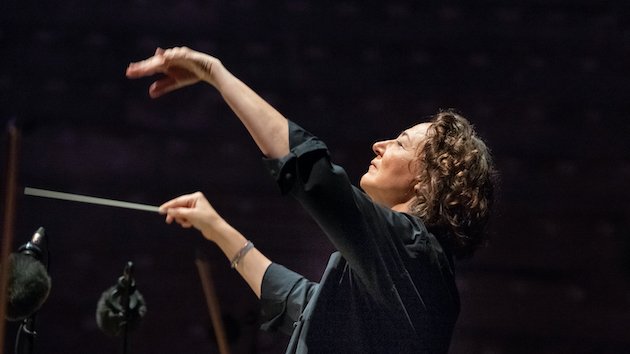
As paradoxical as this review’s title may be, so is the contralto voice. Full and at ease in the nether reaches, the true contralto frequently ascends to the high mezzo and even soprano ranges. Ultimately, it is the strength and quality of the voice at its extremes, and the amount of “push” required to move between them, that determine the vocal classification.
 If anyone has the right to reclaim repertory that was previously thought to have been written for castrati and countertenors, and to issue an album with the simple title of Contralto, it is French singer/conductor Nathalie Stutzmann (b. 1965). For well over three decades, she and the older and late-to-be-recognized-in-America Eva Podleś reigned supreme in the Baroque and bel canto contralto repertoire. But Stutzmann’s path has remained unique, as much for her expansion into the conducting realm as for her generous embrace of French and German art song in addition to Baroque repertoire. Her second recording, issued in 1985, was of Brahms, and her traversal of Schubert’s Winterreise is exceptional in its vocal and interpretive brilliance.
If anyone has the right to reclaim repertory that was previously thought to have been written for castrati and countertenors, and to issue an album with the simple title of Contralto, it is French singer/conductor Nathalie Stutzmann (b. 1965). For well over three decades, she and the older and late-to-be-recognized-in-America Eva Podleś reigned supreme in the Baroque and bel canto contralto repertoire. But Stutzmann’s path has remained unique, as much for her expansion into the conducting realm as for her generous embrace of French and German art song in addition to Baroque repertoire. Her second recording, issued in 1985, was of Brahms, and her traversal of Schubert’s Winterreise is exceptional in its vocal and interpretive brilliance.
That the album’s cover pictures Stutzmann sporting the same sort of black leather motorcycle jacket that she wore at the start of her career, when she mixed motor bikes with classical music, seems appropriate to the valedictory nature of the recording. In April 2019, just two months after she and her decade-old Baroque orchestra, Orfeo 55, finished recording Contralto in France’s Salle des concerts à Arras Baroque theater, she was forced to shut the orchestra down due to a lack of funding. Quite recently, however, she was engaged as the newly named principal guest conductor of the Philadelphia Orchestra. How this development, along with her current position as chief conductor of Norway’s Kristiansand Symphony Orchestra, will affect the arc of her singing career has yet to be seen. What is more certain, however, is that this recording must probably serve as Orfeo 55’s farewell.
All the more reason, then, to celebrate the remarkable artistry on Contralto’s mix of 21 vocal and orchestral tracks and six bonus digital-only tracks. Stutzmann’s astoundingly strong and rich voice, which sounds virtually unchanged from her early recordings, seems right at home in both the male and female roles that Handel, Vivaldi, Nicola Porpora, and others reserved for their favored low-voiced women. As an homage, the recording’s booklet lists the singer who originated each aria and explains the extent to which the music’s range and virtuosic ornamentation (or lack thereof) reflected each artist’s strengths and limitations.
In retrospect, the rapid, virtuosic nature of the opening selection, Irene’s “Dal crudel che m’ha tradita” (From the cruel one who betrayed me) from Handel’s Tamerlano, was perhaps not the wisest choice. At least once, the huge jump from high to low reveals tonal discontinuity in Stutzmann’s voice, and a few briefly touched notes are sounded with the vibrato’s undertones predominant. But in virtually every other selection, Stutzmann’s voice is so beautiful, and the emotion that motivates her interpretation so appropriate, that the recording is all but guaranteed to bring joy to lovers of Baroque music.
Take, for example, the huge range, quiet “B” section, propulsive energy, and gorgeous low tones of Asteria’s recitative and aria, “È morto, si tiranno, io stessa il vidi ... Svena, uccidi, abbatti, atterra” (Yes, he is dead, you tyrant, I myself saw him die .. Stab me, kill me, destroy me, strike me down) from Vivaldi’s Bajazet, and the energetic extremes of Statira’s “Mira d’entrambi il ciglio” (Look both men in the eye) from Porpora’s Statira. Other artists may sing them as well, but none will put Stutzmann’s unique stamp on this music. These are but two of many vocal contributions that I expect you’ll want to play over and over.
Venturing outside the box, as Stutzmann is prone to do, she seems to comment on some of the over-the-top emotion displayed by female characters who, after all, were created in the minds of male composers and librettists. I could be wrong, but in both Semiramide’s “Tradita, sprezzata” (Scorned and betrayed) from Porpora’s Semirarmide riconosciuta and Griselda’s “Caro Addio, dal labbro amato” (Dear Farewell who issued from the lips I love) from Bononcini’s Griselda, Stutzmann sounds as if she’s mocking these characters’ excessive emotional displays. Nor is she alone in this respect; Joyce DiDonato, on her Stella di Napoli recording, had a ball playing up the camp aspect of the florid writing assigned to some of her female Baroque characters.
Stutzmann’s conducting is as emphatic as her singing. Handel’s overture to Ariodante is one of several examples where she places such strong emphasis on rhythmic strumming as to sometimes compete with other aspects of the instrumental fabric. On one of the collection’s most recorded arias, Farnace’s “Gelido in ogni vena” (My blood runs cold in every vein) from Vivaldi’s Il Farnace, you’ll encounter far more emphasis on this strumming than on Cecilia Bartoli’s rendition with Il Giardino Armonico, conducted by Giovanni Antonini.
Both orchestras, however, are far lighter in their approach than on monster countertenor Franco Fagioli’s version with Il Pomo D’Oro under Zefira Valova, where the orchestra indulges in as many variations and ornaments as Fagioli usually does. When all is said and done, no one can produce high tones as sweet, limpid and pathetic as Bartoli, whose orchestra supports her 100 percent. But where Bartoli lightens to sound soprano-like, Stutzmann remains a darker, richer, and more emphatic contralto throughout her range. (The real surprise may be countertenor Dmitry Sinovsky, who on his recording with his La Voce Strumentale pulls out all the emotional stops in Stutzmann-like fashion.)

Music lovers with subscriptions to either Tidal or Qobuz can hear Contralto in high-resolution, with Tidal offering the option to unfold to superior 24/96 MQA. (The Tidal app can play MQA through your phone or pad.) You can also download the Erato album in both CD quality (16/44.1) and hi-rez (24/96) from HDTracks and other services. Whether you go that route or stick to CD, I can’t imagine that you’ll wind up other than delighted by what you hear.




